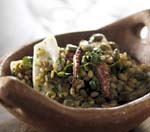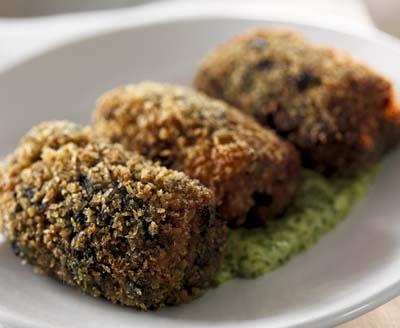Mark Hix cooks with squid and cuttlefish
Cooking with squid and cuttlefish is a joy, says Mark Hix, especially when it’s locally caught


Cuttlefish croquettes
Makes 20
I had this dish in a tapas bar in Seville, and it was one of the best things I've eaten for a long time. I liked it so much that I put it on the menu at the Oyster & Fish House. It's a real surprise to bite through the crisp breadcrumb coating and into a jet-black, silky filling. A good fishmonger should be able to get you sachets of cuttlefish or squid ink, or you can buy it in Italian delis. You can make these a few days in advance, or even keep them in the freezer until you need them. Serve them as they are as a snack or as a starter with herb, watercress or wild-garlic mayonnaise.

Ingredients
400g-450g cuttlefish, cleaned weight, cut into 5cm-6cm chunks and lightly scored A little vegetable or corn oil for frying Salt and freshly ground black pepper 130g butter 2 large shallots, finely chopped 2 garlic cloves, peeled and crushed 150ml white wine 500ml fish stock 100g plain flour 5 sachets of squid ink (about 20g) 3-4tbsp plain flour for coating 2 medium eggs, beaten 50g-60g fresh white breadcrumbs Vegetable or corn oil for deep-frying Method Melt 30g of the butter in a heavy saucepan and gently cook the shallots and garlic for a couple of minutes until soft, then add the white wine, fish stock and cuttlefish. Bring to the boil and simmer very gently for about an hour, or until the cuttlefish is tender. Check the cuttlefish at regular intervals, as it may well take less time than this. Remove the pieces of cuttlefish and put to one side to cool.
In a clean, thick-bottomed pan, melt the rest of the butter, add the flour and stir over a low heat for a minute or so. Gradually whisk in the hot cooking liquor to avoid lumps forming, then add the ink, squeezing out as much as you can from the packets (you can swish them out in the stock first). Bring to a simmer, and continue simmering very gently for about 20-30 minutes, stirring regularly so it doesn't stick to the bottom. The sauce should be really thick and gluey, with an almost mashed-potato consistency. Remove from the heat and leave to cool.
Meanwhile, finely chop the cuttlefish and mix in with the sauce, re-season if necessary, and add a little lemon juice. Place the mix in the fridge for a few hours, or overnight, then transfer to a piping bag with a 2cm-3cm nozzle and pipe in long lines onto a tray lined with greaseproof paper or clingfilm. Place the tray in the freezer for an hour, then cut the lines into 2cm lengths.
Sign up for the Country Life Newsletter
Exquisite houses, the beauty of Nature, and how to get the most from your life, straight to your inbox.
Have three bowls ready, one with the flour, the second with the beaten egg, and the third with the breadcrumbs. Carefully flour the croquettes, shaking off any excess, then put them through the egg and finally the breadcrumbs, re-shaping them with a palette knife if necessary. Refrigerate until required.
Preheat about 8cm of oil to 160˚-180˚C in a large thick-bottomed saucepan or electric deep-fat fryer. Fry the croquettes a few at a time, turning them as they're cooking, for 2-3 minutes, then drain them on some kitchen paper.
Squid and spelt salad Serves 4
Squid come in different shapes and sizes, and for this dish, that's absolutely fine, as long as it's fresh. Cuttlefish can be used in exactly the same way. If you buy it uncleaned it should have a certain amount of ink in its body pouch, which you can save, although it can be gritty.
Ingredients
60g spelt, soaked for 3-4 hours in cold water and rinsed 200g-250g squid, cleaned weight, tentacles and all 100ml olive oil 3-4tbsp chopped parsley 2tbsp capers 1 chilli, finely chopped 6 spring onions, finely chopped The juice of two lemons Salt and freshly ground black pepper
Method
Cook the spelt in boiling, salted water for 15 minutes or so until it's tender, then drain in a colander. Cut the squid into rough 2cm-3cm pieces, dry them on some kitchen paper and season.
Heat a tablespoon of the oil in a ribbed griddle pan or heavy frying pan, and cook the squid on a high heat for a minute or so, stirring as it's cooking until it's lightly coloured. Transfer to a bowl, juices and all, and stir in the spelt, the rest of the olive oil, the parsley, capers, chilli, spring onions and lemon, and season to taste.
Leave the salad to stand for 30 minutes, stirring every so often, then serve.
Mark Hix's ‘Seasonal Food' is available from Quadrille at £25
to Country Life and save over £50 a year
Country Life is unlike any other magazine: the only glossy weekly on the newsstand and the only magazine that has been guest-edited by HRH The King not once, but twice. It is a celebration of modern rural life and all its diverse joys and pleasures — that was first published in Queen Victoria's Diamond Jubilee year. Our eclectic mixture of witty and informative content — from the most up-to-date property news and commentary and a coveted glimpse inside some of the UK's best houses and gardens, to gardening, the arts and interior design, written by experts in their field — still cannot be found in print or online, anywhere else.
-
 380 acres and 90 bedrooms on the £25m private island being sold by one of Britain's top music producers
380 acres and 90 bedrooms on the £25m private island being sold by one of Britain's top music producersStormzy, Rihanna and the Rolling Stones are just a part of the story at Osea Island, a dot on the map in the seas off Essex.
By Lotte Brundle
-
 'A delicious chance to step back in time and bask in the best of Britain': An insider's guide to The Season
'A delicious chance to step back in time and bask in the best of Britain': An insider's guide to The SeasonHere's how to navigate this summer's top events in style, from those who know best.
By Madeleine Silver